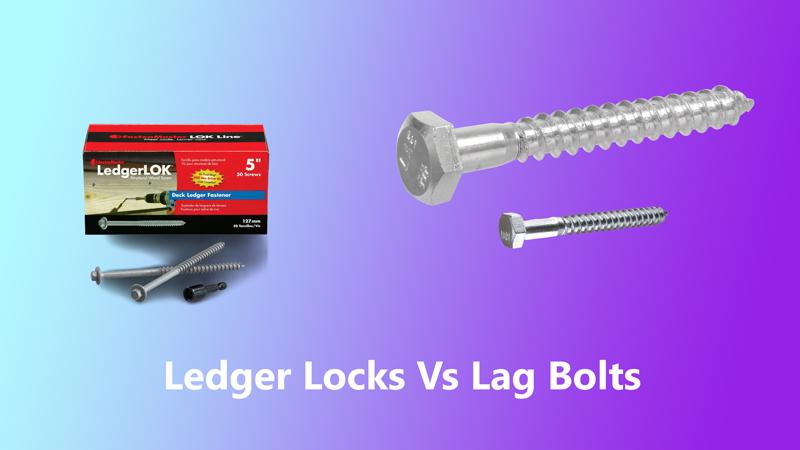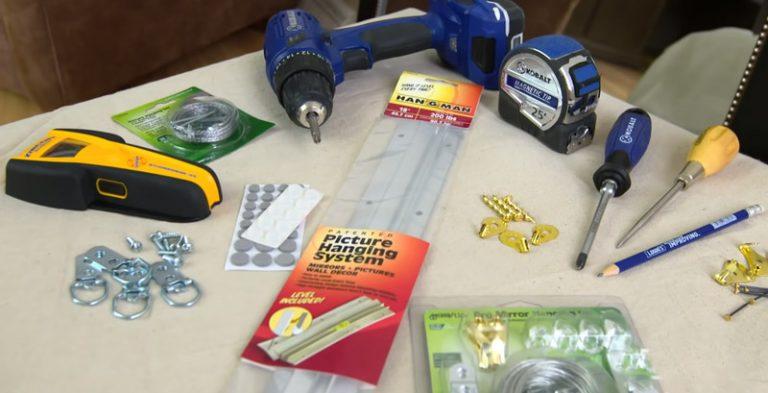Ledger Locks Vs. Lag Bolts [Which is Better?]

Construction and home improvement projects often require the use of fasteners to create strong and secure connections between different materials. Ledger locks and lag bolts are two common types of fasteners that are used for a variety of applications.
Both have their own unique properties and characteristics, and choosing the right fastener for a specific project can be crucial to the success and stability of the finished project.
In this article, we will explore the differences between ledger locks and lag bolts, including their materials, shapes, ease of installation, durability, cost, and availability.
We will also discuss the pros and cons of each type of fastener and provide some tips on how to choose the best option for your project.
Whether you are a contractor or a DIY enthusiast, understanding the differences between ledger locks and lag bolts can help you make informed decisions and ensure the safety and stability of your projects.
You'll Learn About
What are Ledger Locks?
Ledger locks are a type of fastener used in construction and home improvement projects. They are designed to provide strong and secure connections between two objects, such as a deck and a house.
Ledger locks are made with heat-treated steel and have a sharp, thin shape that allows them to be easily installed into wood or other materials.
Properties of Ledger Locks
- Made with heat-treated steel: This makes ledger locks strong and durable, able to withstand high levels of stress and pressure.
- Sharp and thin shape: The sharp, thin shape of ledger locks allows them to be easily inserted into wood or other materials. This makes installation easier and faster, as there is no need for pre-drilling.
- Easier and faster installation: Ledger locks can be easily installed using a wrench, making the process quicker and more efficient.
- Highly durable: The heat-treated steel and sharp, thin shape of ledger locks make them highly durable and able to withstand heavy loads and harsh weather conditions.
Advantages of Ledger Locks
- Strength: The strength of ledger locks is one of their main advantages. They are designed to provide strong and secure connections between two objects, making them suitable for use in a variety of construction and home improvement projects.
- Durability: Ledger locks are made with heat-treated steel, which makes them highly durable and able to withstand heavy loads and harsh weather conditions.
- Ease of installation: Ledger locks are easy to install, as they do not require pre-drilling and can be installed using a wrench. This makes the process faster and more efficient.
Disadvantages of Ledger Locks
- Expense: Ledger locks are more expensive than some other types of fasteners, such as lag bolts. This may be a disadvantage for those working on a tight budget.
- Medium availability: Ledger locks may not be widely available at all hardware stores or online retailers, which can make them more difficult to find.
What are Lag Bolts?
Lag bolts, also known as lag screws, are a type of fastener used in construction and home improvement projects. They are designed to provide strong and secure connections between two objects, such as a beam and a support post.
Lag bolts are made with materials such as silicon bronze, steel, or stainless steel, and have a larger diameter and longer length compared to ledger locks.
Properties of Lag Bolts
- Made with silicon bronze, steel, or stainless steel: Lag bolts are made with a variety of materials, each with its own unique properties. Silicon bronze is corrosion-resistant and has a high tensile strength, steel is strong and durable, and stainless steel is resistant to rust and corrosion.
- Larger diameter and longer length: Lag bolts have a larger diameter and are longer than ledger locks, which can make them more difficult to install.
- Generic shape: Lag bolts come in generic shapes, rather than specific shapes and sizes like ledger locks.
- Slower and more difficult installation: Lag bolts require pre-drilling two holes before they can be installed, which can make the process slower and more difficult compared to ledger locks.
- Medium durability: Lag bolts are not as strong and durable as ledger locks, as they are made with materials that are not as strong.
Advantages of Lag Bolts
- Affordability: Lag bolts are generally more affordable than ledger locks, making them a more budget-friendly option for those working on a tight budget.
- High availability: Lag bolts are widely available at most hardware stores and online retailers, making them easy to find and purchase.
Disadvantages of Lag Bolts
- Not as strong as ledger locks: Lag bolts are not as strong as ledger locks, as they are made with materials that are not as strong. This may make them less suitable for use in certain applications where high levels of strength are required.
- Slower and more difficult installation: The requirement for pre-drilling two holes before installation can make the process of installing lag bolts slower and more difficult compared to ledger locks.
Comparing Ledger Locks and Lag Bolts
Here is a comparison of the key properties and characteristics of ledger locks and lag bolts:
| Property | Ledger Locks | Lag Bolts |
| Material | Heat-treated steel | Silicon bronze, steel, or stainless steel |
| Shape | Sharp and thin | Larger diameter and longer |
| Ease of installation | Easier and faster | Slower and more difficult (requires pre-drilling) |
| Durability | Highly durable | Medium durability |
| Cost | More expensive | More affordable |
| Availability | Medium | High |
As you can see, ledger locks and lag bolts have some differences in terms of their properties and characteristics. Ledger locks are made with heat-treated steel and have a sharp, thin shape, which makes them strong and durable. They are also easier and faster to install, as they do not require pre-drilling. However, they are more expensive and have medium availability.
On the other hand, lag bolts are made with materials such as silicon bronze, steel, or stainless steel and have a larger diameter and longer length. They are slower and more difficult to install, as they require pre-drilling. Lag bolts are also not as strong and durable as ledger locks, but they are more affordable and have higher availability.
When it comes to choosing between ledger locks and lag bolts, it ultimately depends on the specific requirements of the project. If strength and durability are the most important factors, then ledger locks may be the better choice. However, if cost and availability are the main considerations, then lag bolts may be the more suitable option. It is important to carefully consider the specific needs of the project and choose the fastener that is best suited to meet those needs.
Frequently Asked Questions
- What are ledger locks and lag bolts used for?
Both ledger locks and lag bolts are used in construction and home improvement projects to provide strong and secure connections between two objects. Ledger locks are commonly used to attach a deck to a house, while lag bolts are often used to secure beams or support posts. - What are the differences between ledger locks and lag bolts?
There are several key differences between ledger locks and lag bolts:
- Material: Ledger locks are made with heat-treated steel, while lag bolts are made with materials such as silicon bronze, steel, or stainless steel.
- Shape: Ledger locks have a sharp, thin shape, while lag bolts have a larger diameter and are longer.
- Ease of installation: Ledger locks are easier and faster to install, as they do not require pre-drilling. Lag bolts require pre-drilling and are slower and more difficult to install.
- Durability: Ledger locks are highly durable, while lag bolts have medium durability.
- Cost: Ledger locks are more expensive than lag bolts.
- Availability: Ledger locks have medium availability, while lag bolts have high availability.
- Can ledger locks and lag bolts be used interchangeably?
It is not recommended to use ledger locks and lag bolts interchangeably, as they have different properties and characteristics and are designed for specific applications.
Using the wrong type of fastener can result in a weaker connection and may compromise the safety and stability of the finished project. It is important to carefully consider the specific requirements of the project and choose the appropriate fastener. - Can ledger locks and lag bolts be used with any material?
Both ledger locks and lag bolts can be used with a variety of materials, including wood and metal.
However, it is important to consider the specific properties and characteristics of the fastener and the material it is being used with in order to ensure a strong and secure connection. - How do I install ledger locks and lag bolts?
To install ledger locks, you will need a wrench. Simply insert the ledger lock into the material and tighten it using the wrench. To install lag bolts, you will need to pre-drill two holes using a drill bit that is slightly smaller than the diameter of the lag bolt.
Then, insert the lag bolt into the holes and tighten it using a wrench. It is important to follow the manufacturer’s instructions and use the appropriate tools to ensure a proper installation.
Editor’s Note
When it comes to choosing between ledger locks and lag bolts, it ultimately depends on the specific application and the requirements of the project. Both types of fasteners have their own unique properties and characteristics, and the best choice will depend on the specific needs of the project.
Ledger locks are known for their strength and durability, as they are made with heat-treated steel and have a sharp, thin shape. They are also easier and faster to install, as they do not require pre-drilling and can be installed using a wrench.
However, they are more expensive and have medium availability, and they also take up less space than lag bolts.
On the other hand, lag bolts are not as strong as ledger locks and are made with materials such as silicon bronze, steel, or stainless steel. They have a larger diameter and are longer, and come in generic shapes.
They require pre-drilling and are more difficult and slower to install, but are more affordable and have higher availability. They also take up more space than ledger locks.
Both ledger locks and lag bolts have their own advantages and disadvantages, and the best choice will depend on the specific requirements of the project. If strength and durability are the most important factors, then ledger locks may be the better choice.
Choosing between ledger locks and lag bolts depends on your specific project needs. Ledger locks offer quick installation and strong holding power, while lag bolts provide durability and resistance to shear forces. Consider the load requirements and material type before making a decision.
If you’re working on home improvements, it’s worth exploring how bats can enter through air conditioners. Additionally, understanding how to reset a Delonghi air conditioner can help you maintain your HVAC system. For more insights, check out why air conditioners are so expensive.
Final Words
Ledger locks and lag bolts are two common types of fasteners used in construction and home improvement projects. Both have their own unique properties and characteristics, and the best choice will depend on the specific needs of the project.
Ledger locks are strong and durable, as they are made with heat-treated steel and have a sharp, thin shape. They are also easier and faster to install, as they do not require pre-drilling. However, they are more expensive and have medium availability.
Lag bolts are made with materials such as silicon bronze, steel, or stainless steel, and have a larger diameter and longer length.
They are slower and more difficult to install, as they require pre-drilling. Lag bolts are also not as strong and durable as ledger locks, but they are more affordable and have higher availability.
When deciding between ledger locks and lag bolts, it is important to consider the specific requirements of the project and choose the fastener that is best suited to meet those needs.
Both types of fasteners have their own advantages and disadvantages, and the right choice will depend on the specific project at hand.
Regardless of which fastener is chosen, it is important to make sure that it is properly installed and used in the appropriate application in order to ensure the safety and stability of the finished project.






